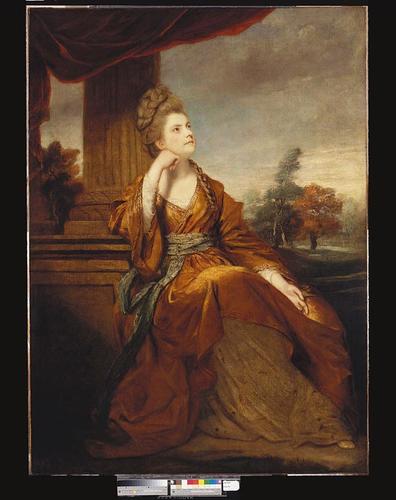-
1 of 253523 objects
Maria, Duchess of Gloucester (1736-1807) 1774
Oil on canvas | 188.0 x 136.5 cm (support, canvas/panel/stretcher external) | RCIN 400698

Sir Joshua Reynolds (1723-92)
Maria, Duchess of Gloucester (1739-1807) 1774
-
When George III was asked by Lord Eglinton to sit for the most fashionable portrait painter of the day, Joshua Reynolds, he replied: ‘Mr Ramsay is my painter, my Lord.’ Reynolds tried to gain royal notice with two speculative ventures – a portrait of George III as Prince of Wales (OM 1011, 401034) and an oil sketch for a depiction of his marriage to Queen Charlotte (OM 1012, 404353) – both of which remained on his hands. Reynolds was knighted by George III, made first president of the Royal Academy and Principal Painter to the King upon Ramsay’s death in 1784, but never asked to paint anything. That the Royal Collection has a fine group of Reynolds is entirely thanks to George IV, who commissioned portraits at the end of the artist’s life and acquired many examples of his earlier work. This work is one of the few examples which joined the collection later.
Maria Walpole (1739-1807) was the illegitimate daughter of Sir Edward Walpole (1706-1784, son of Sir Robert); she was brought up at Frogmore House in Windsor (subsequently a Royal Residence). In 1759 she married James, 2nd Earl Waldegrave (1715-63) and was soon widowed after having borne him three daughters. In 1766 she was secretly married to George III’s brother, Prince William Henry, Duke of Gloucester (1743-1805), which fact leaked out after the passing of the Royal Marriages Act in 1772, intended to prevent exactly this sort of thing (royals marrying commoners without the King’s permission). Their son, William Frederick (1776-1834), married George III’s daughter, Princess Mary (1776-1857). Their daughter, Sophia Matilda (1773-1844), bequeathed this painting to Prince Albert, both actions perhaps suggesting the process of bringing strays back into the family.
This portrait was painted in 1774 and exhibited at the Royal Academy in that year, where it was criticised for being painted in colours which had already begun to fade. The imagery is typical of the ‘Age of Sensibility’ in stressing the dreamy, nature-loving soulfulness of the sitter. She is shown with head turned half to the right and inclined upwards. She is leaning her right elbow on the plinth of a column to the left, her other arm on her lap; wearing a bronze-coloured classical robe tied with a 'Turkish' sash.Provenance
Bequeathed to Prince Albert by the sitter's daughter in 1844; recorded in the Prince Consort's Organ Room at Buckingham Palace in 1868
-
Creator(s)
Acquirer(s)
-
Medium and techniques
Oil on canvas
Measurements
188.0 x 136.5 cm (support, canvas/panel/stretcher external)
Category
Object type(s)
Other number(s)
Alternative title(s)
Maria, Countess Waldegrave (1739-1807), later Duchess of Gloucester